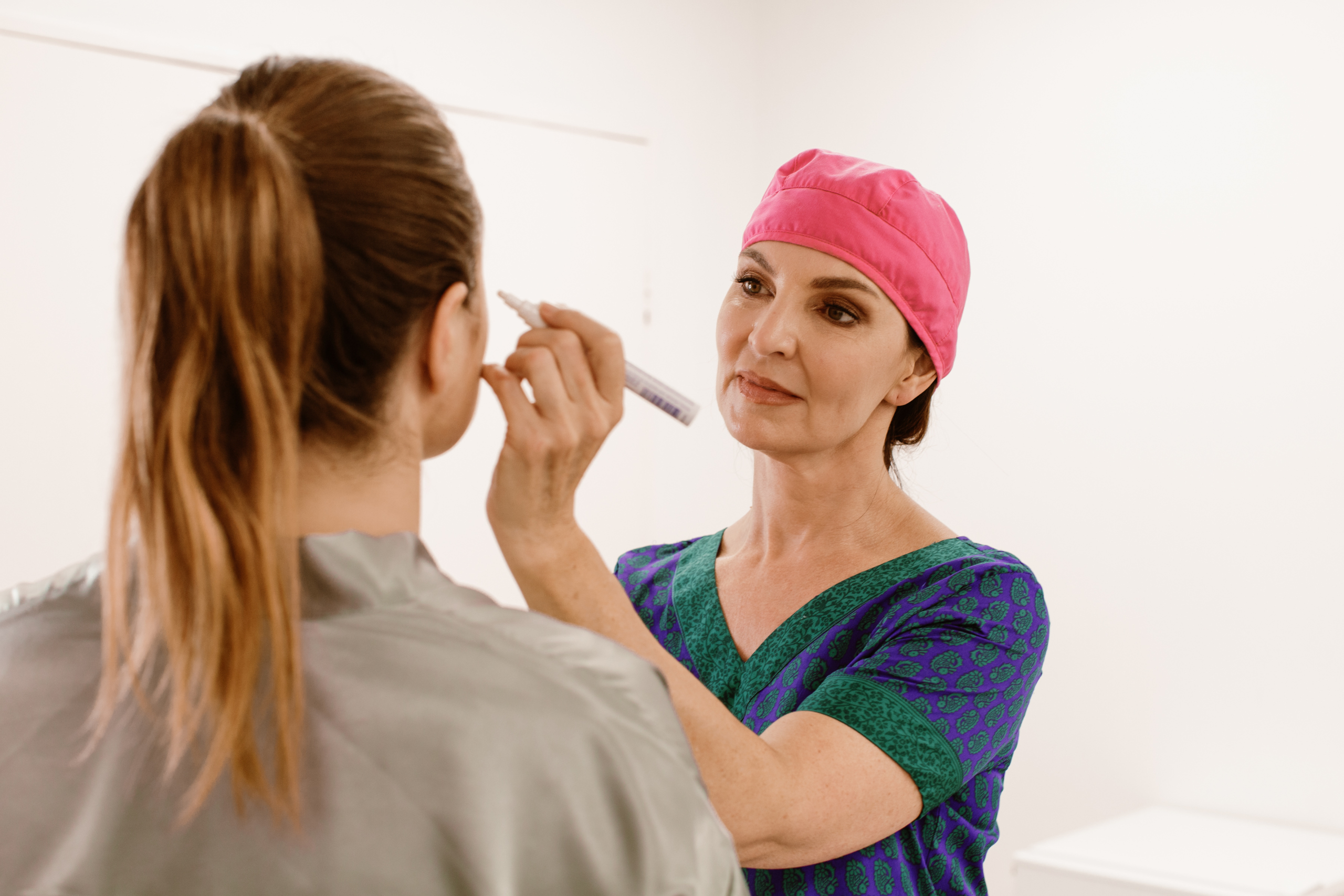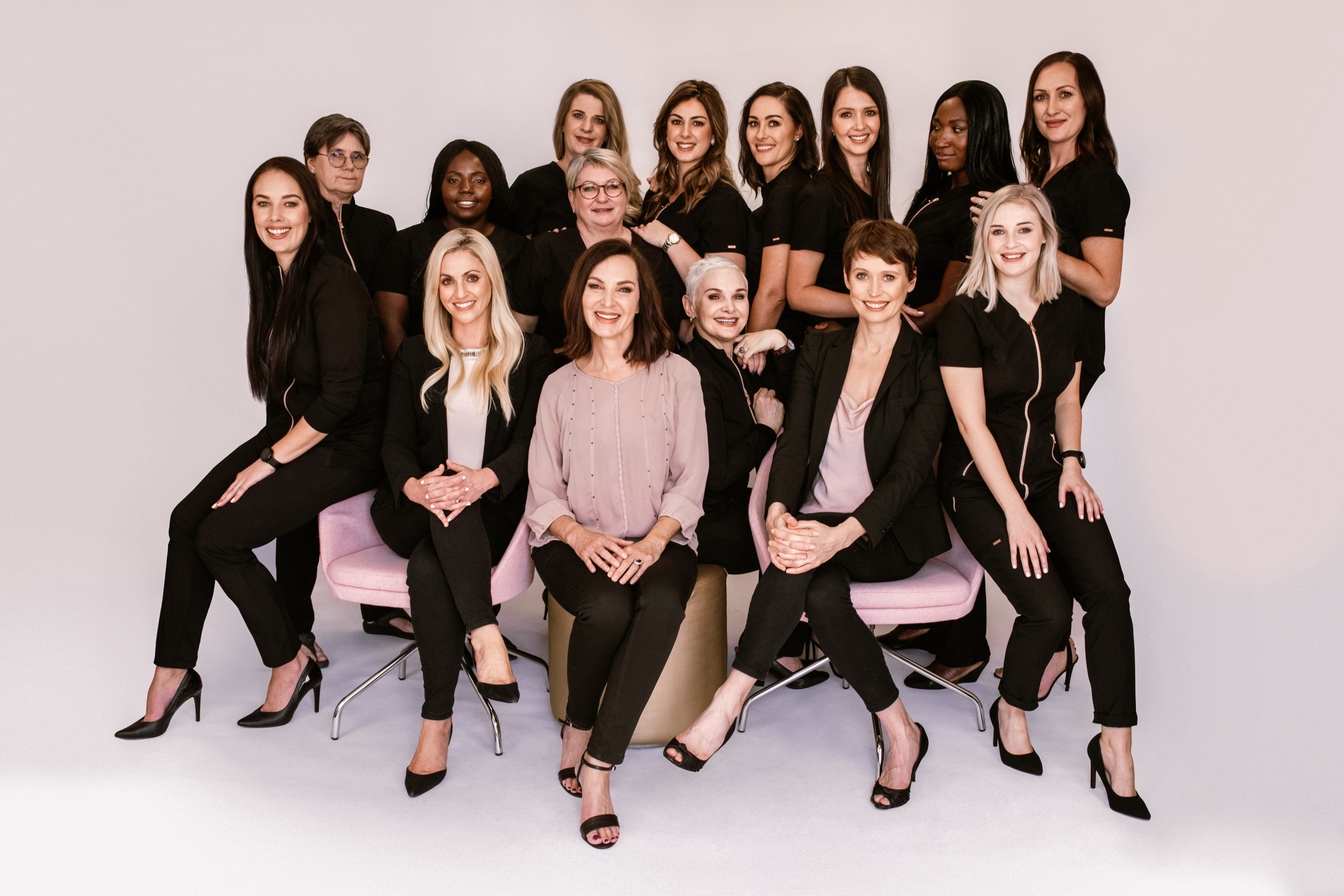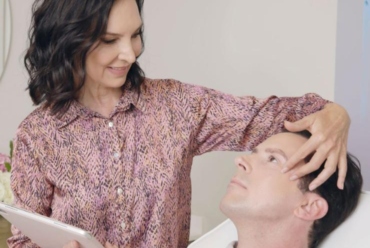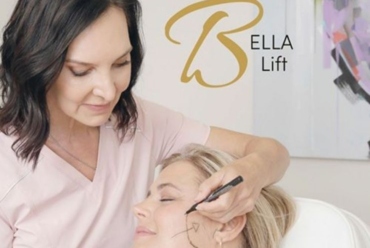Facelift Surgery in South Africa
TURN BACK TIME AND RESTORE YOUR YOUTHFUL APPEARANCE WITH A FACELIFT
Facelift surgery is a transformative procedure that Dr Nerina Wilkinson highly recommends for both men and women seeking to reclaim their youthful appearance.
Many of her patients express concerns about sagging facial skin and the loss of facial contours, and are thrilled with how a facelift can rejuvenate their overall appearance, enhancing natural beauty and restoring youthful vitality.
What is a Facelift?
A facelift, or rhytidectomy, is a relatively major surgical procedure done to remove excess skin and fat from the face to address signs of ageing such as jowls, deep folds, and loose neck skin.
Dr Nerina Wilkinson’s approach combines traditional lifting techniques with volume replacement (such as with her signature StemCell4DLift™) achieving natural-looking results that refresh the entire face.
This method contours the face naturally while also improving skin quality, avoiding the ‘windswept’ look that can result when only skin tightening methods are employed.
Facelifts are often complemented by eyelid surgery or neck liposuction for comprehensive rejuvenation.
Learn more about our approach, how facelift treatments work, and contact us to book a consultation.
Learn More
Frequently asked questions about Facelift Surgery (Rhytidectomy)
What is Rhytidectomy?
Rhytidectomy, commonly known as a facelift, is a surgical procedure that reduces visible signs of ageing by removing excess skin, tightening underlying tissues, and recontouring the face and neck. This procedure aims to restore a more youthful and refreshed appearance.
Our approach to facelift surgery (Rhytidectomy)
Dr Nerina Wilkinson’s approach to facelift surgery combines techniques from a traditional facelift with volume replacement using procedures such as her signature StemCell4DLift™.
This method avoids the unnatural, windswept look seen in some celebrities by restoring malar volume and smoothing transitions between facial features by using the individual’s own fat (known as fat grafting), or what Dr Nerina loves to call “liquid gold”.
The result is a lasting youthful appearance that is preserved over the years. This is achieved by enhancing the cheekbones, redefining the jawline, softening under-eye hollows, or naturally lifting the brows (depending on the patient’s concerns). Volume can also be added to the eyebrows and forehead, which opens the eyes without altering their shape—a common issue with previous surgical techniques.
Dr Wilkinson has advanced this practice into a 4D approach, extending patient care post-surgery with dermal filler injectables and muscle relaxing injections to maintain dynamic, natural-looking results over time.
This holistic strategy ensures a rejuvenated appearance that evolves gracefully with the patient.
Who is the ideal candidate for a facelift?
You may benefit from a facelift if you stand in front of the mirror and pull your skin upwards to improve your jowls and neckline.
The ideal patient, however, is someone who still has some elasticity in the skin and has cared for their face well. If your skin is very damaged, it may be suggested that we improve the quality of your skin with skincare or CO2RE® Fractional Laser Resurfacing before proceeding with the final facelift procedure.
A youthful face has contours and fresh, glowing skin. Tightening the sagging skin alone will never achieve a refreshed and rejuvenated result. The trend is for patients to embark on facial surgery at a younger age to maintain a youthful appearance rather than wait for extensive sagging before making the surgical leap.
If you’re in your mid-40s to late 60s and want to look fresh-faced and camera-ready, consider undergoing a facelift.
How is facelift surgery performed?
A facelift usually takes several hours and sometimes longer if you’re having more than one procedure done. Every surgeon approaches a facelift in his or her own way. Some complete one side of the face at a time, and others move back and forth between the sides.
The exact placement of incisions and the sequence of events depend on your facial structure and your surgeon’s technique. Incisions usually begin above the hairline at the temples, extend in a natural line in front of the ear, and continue behind the earlobe to the lower scalp. A small incision may also be made under the chin if neck improvement surgery is required.
In general, Dr Nerina Wilkinson separates the skin from the fat and muscle below. Fat may be trimmed or suctioned from around the neck and chin to improve the contour. She then tightens the underlying muscle and membrane, pulls the skin back, and removes the excess. Stitches secure the layers of tissue and close the incisions; metal clips may be used on the scalp.
At this point, she often injects fat into the areas that need added support to enhance the facelift’s result. Following surgery, a small, thin drain is temporarily placed under the skin behind your ear to drain any blood that might collect there. It is usually removed the following day.
Your head is loosely wrapped in bandages to minimise bruising and swelling and may be removed the next day when the drains are removed.
How long does a facelift take to perform?
A facelift typically requires several hours to complete, depending on the complexity and scope of the surgery. Most procedures last between 4 to 6 hours.
If additional treatments such as eyelid surgery or neck liposuction are performed simultaneously, the procedure’s duration may need to be extended further.
Each surgery is tailored to the individual’s specific needs, and your surgeon will provide a more accurate timeline during your consultation.
How long do results from a facelift last?
There is no correct answer here as we and our surgeons are all unique; for most patients, however, the results of a facelift last about 10 years – after 10 years some patients often require further rejuvenation.
Dr Nerina Wilkinson aims to achieve a natural, rejuvenated look in all her patients. Therefore, in most cases, she combines her facelift with lipofilling (facial fat grafting), dermal filler treatments, and muscle-relaxing injections post-surgery. This adds to the lifespan of a conventional facelift and ensures a persistently natural and rejuvenated look.
Facelift (Rhytidectomy): Before and After
Undergoing a facelift at Dr Nerina Wilkinson + Associates marks the beginning of your rejuvenation journey towards a more youthful appearance. It is crucial to follow the pre and post-procedure guidelines meticulously to maximise your results and enhance the recovery process. Adhering to these specially designed instructions prepares your face for the transformation and ensures the lasting impact of your revitalised, youthful look.
What to do before a facelift
Preparing for your facelift with Dr Nerina Wilkinson + Associates is crucial for ensuring the success of your procedure and a smooth recovery. Here’s what you should do:
- Complete preoperative tests: Attend and complete all preoperative assessments recommended by Dr Wilkinson to ensure your readiness for surgery.
- Stop smoking: Cease smoking at least 4 weeks before and after your surgery, as nicotine can impair blood flow and hinder healing.
- Manage medications and supplements: Discontinue taking aspirin, anti-inflammatories, herbal supplements, and any diet pills at least 2 weeks prior to surgery to minimise the risk of bleeding.
- Arrange for assistance: Plan for someone to drive you to and from the clinic, as you will not be able to drive for at least 24 hours after your procedure.
- Prepare for recovery: Organise essential recovery items at home, such as easy-to-eat meals, comfortable pillows, and activities to enjoy while resting.
- Pre-operative consultation: Schedule a final plastic surgery consultation with Dr Wilkinson one week before your surgery to discuss any last-minute details and ensure everything is set for your procedure.
Following these steps will help you prepare adequately for your facelift, aiming for the best possible outcomes and a rejuvenating transformation.
Day of the facelift
On the day of your facelift surgery at Dr Nerina Wilkinson + Associates, you reach a pivotal moment in your aesthetic journey. To ensure everything goes smoothly, please follow these guidelines:
- Medication: Continue taking any essential medications, such as those for blood pressure or diabetes, with a small sip of water in the morning.
- Attire: Wear comfortable, loose-fitting clothes and easy-to-remove shoes to facilitate ease before and after surgery.
- Personal items: Bring sunglasses and a hat or scarf to discreetly protect your face and maintain privacy as you depart from the clinic.
- Staff support: Our dedicated team will attend to your needs throughout your stay and recovery and arrange a follow-up appointment with Dr Wilkinson.
What to Bring:
- Medications: Have any prescribed postoperative medications ready.
- Essentials only: Leave valuables and jewellery at home to avoid losing them.
- Communication: You are welcome to bring your mobile phone and charger, which can be stored securely at your bedside.
After the facelift
Following your facelift surgery at Dr Nerina Wilkinson + Associates, you will be admitted as a day patient and may stay in our postoperative care facilities for 1-4 nights. During this time, our expert ward nurses will provide attentive care using ice and light therapy to accelerate your healing process.
Post-Surgery Experience:
- Immediate aftercare: Drains and bandages are typically used to manage swelling and are usually removed within the first 2 days. You’ll be discharged with your head lightly wrapped to minimise swelling and protect the surgical sites.
- Healing process: Expect significant swelling and discomfort during the first 5 days, transitioning to manageable discomfort and bruising over the next 2 weeks. Most patients feel confident enough to socialise after about two weeks.
- Follow-up care: Your follow-up appointments will include checking on your healing progress and making necessary adjustments to your care plan. These are critical to ensuring your recovery is on track.
Important Post-Surgery Instructions:
- Sun exposure: Avoid direct sunlight for the first 6 weeks to protect sensitive skin and prevent hyperpigmentation.
- Care and maintenance: Detailed instructions for post-treatment care will be provided, helping you manage the healing process at home.
- Scheduled appointments: Post-operative visits are essential, including early appointments for dressing changes and subsequent ones for progress evaluation and stitch removal.
How long is the recovery period for a facelift?
It may take you a few weeks to feel like your old self again. Some people return to work two weeks after their facelift surgery, while others take three or four weeks to rest and recuperate.
You should be up and about in a day or two, but plan on taking it easy for the first week after surgery. Be especially gentle with your face and hair since your skin will be tender and numb and may not respond normally at first.
Dr Wilkinson will give more specific guidelines for gradually resuming your normal activities.
How much does a facelift cost in South Africa?
The costs of the procedure will depend on the time spent in the theatre. You and Dr Wilkinson will discuss this during your first assessment/consultation.
The average costs are as below:
Mini Facelift: +/- R 95 000 – R 110 000
Full Facelift: +/- R 180 000 – R 200 000
Face & Neck lift: +/- R 220 000 – R 240 000
For this procedure, we would require you to stay at our overnight clinic for 2 nights.
Additional costs to expect:
* Consultation fee: R 2 850
* Medication required for surgery: +/- R 1 400 – R 1 600
* Additional overnight at our facility, other than recommended by us: +/- R 8 500
* Other investigations advised by the practice at the consultation
Are there alternatives to a facelift?
Yes, there are several surgical alternatives to a facelift for those seeking to rejuvenate their facial appearance:
- Traditional Eyelid Surgery (Blepharoplasty): This procedure focuses on removing or repositioning sagging skin around the eyelids, reducing the hooded appearance of the upper eyelids and the bags under the lower eyelids, thus alleviating a tired look.
- EYELight360™ is a signature eyelid rejuvenation procedure combining targeted fat grafts, nano fat regeneration, CO2RE® Fractional Laser Resurfacing, and optional muscle relaxing injections.
- Lipofilling (Facial Fat Grafting): Enhances facial features by using your own body fat to fill in wrinkles and sunken areas, offering a rejuvenated effect.
- StemCell4DLift™: A cutting-edge, scarless facelift alternative that combines fat grafts, adipose-derived stem cells (ADSC), CO2RE® Fractional Laser Resurfacing, and muscle-relaxing injections to volumise and improve skin quality for comprehensive rejuvenation.
- BELLA Lift: This procedure reduces the most visible signs of ageing by tightening underlying muscles and re-draping the skin of your mid-face.
Each of these alternatives has unique benefits and can be tailored to meet individual needs and aesthetic goals. To determine the most suitable option for you, consider booking a consultation with Dr Nerina Wilkinson.
Is facelift surgery safe?
Facelift surgery is generally safe when performed by a qualified plastic surgeon like Dr Nerina Wilkinson. However, as with any surgical procedure, there is always the possibility of complications.
During your facelift consultation, Dr Nerina Wilkinson will provide a detailed overview of the facelift procedure, discussing the inherent risks and possible complications. She will assess factors that could influence the outcome, including your age, medical history, lifestyle, and habits.
Dr Nerina will also discuss your expectations and ensure you have a thorough understanding of what to expect during the recovery period following a facelift. This comprehensive approach helps prepare you for the procedure and contributes to a safer, more predictable outcome.
What are the possible risks and complications associated with facelift surgery?
While facelift surgery, under the expertise of Dr Nerina Wilkinson, is designed to be a safe and effective procedure, it is important for patients to be aware of potential risks and complications, as with any surgical treatment. These include:
- Common postoperative side-effects: Patients may experience temporary numbness, swelling, and bruising around the treated areas. These effects are usually short-lived and resolve during the initial recovery period.
- Minor complications: Some individuals might experience slight asymmetry between the sides of the face or minor scarring along the incision lines. These issues can often be corrected or improved over time.
- Rare complications: Though infrequent, more serious complications such as nerve injury, which can lead to muscle weakness or loss of facial expressions, and hematoma, a significant accumulation of blood beneath the skin, can occur.
- Healing effects: Patients may also encounter complications related to healing, such as delayed wound healing or infection, particularly in smokers or those with certain medical conditions.
To minimise these risks, it is crucial to follow all pre and post-operative instructions provided by Dr Wilkinson.
A comprehensive facial plastic surgery consultation before the surgery will address any concerns and ensure you are fully informed about the procedure’s benefits and potential side effects. It also helps us prepare for a safe and well-planned treatment tailored to your needs.
Where is facelift surgery performed in Cape Town?
Facelift surgery is performed at Dr Nerina Wilkinson + Associates, located in the prestigious V&A Waterfront in Cape Town.
Our top-tier clinic is renowned for its combination of advanced surgical technologies and elegant settings, providing expert care in a sophisticated environment. This ensures that every facelift procedure is carried out with the highest level of precision and attention to detail.
The
Facelift Procedure Process
In order to evaluate your suitability for the procedure, and to make a professional and educated decision regarding your facelift, Dr Nerina Wilkinson will carefully consider factors such as your age, face shape, and skin condition.
Together you will assess your facial features in a mirror and with photographs taken during your consultation.
During your examination, she will examine your face for loss of deeper soft tissue, skin excess/laxity, and the tightness of the underlying muscles. Be frank about your expectations. She will describe the different options available and the risks and limitations of each.
It is important for you to stop smoking well in advance of surgery if you are a smoker (smoking decreases blood flow to the skin and therefore affects the healing process). You will also be advised to avoid certain medications which can increase bleeding prior to surgery. Clinic staff will provide you with any additional pre-op instructions specific to your case.
Note that enjoying a healthy eating and exercise regime before and after surgery will result in optimum results. To hide the initial scars, it is advisable that you grow your hair before the procedure.
Dr Wilkinson encourages her patients to bring photographs from their past. Her ultimate goal is to restore a patient’s natural youthful face without dramatically changing their facial features.
Post-consultation, you need to take into account the reality of the procedure, its cost and the required recovery time.
Additionally, you’re encouraged to ask as many questions as you can and conduct your own research on rhytidectomy surgery before setting a date for the procedure.
For your rhytidectomy procedure, you’ll be admitted as a day patient at the Renaissance Surgical clinic. Dr Nerina Wilkinson will examine you in the ward and draw markings of the planned surgery and incisions on your face.
The facelift is performed while you’re placed under conscious sedation, which will make you feel drowsy and relaxed. However, you’ll sleep through the entire operation and not be aware of the procedure.
The advantage is that you will wake up feeling refreshed without the side effects of general anaesthesia. She may use it to perform some facelifts. In all cases, a certified female anaesthetist will be responsible for your well-being.
The facelift surgery usually takes between 2 and 5 hours and involves:
- Incisions – Fine skin incisions are made to hide in the sideburns and extend down a natural crease, in front of the ear. From there, the incision continues underneath the earlobe to behind the ear, ending in the scalp area of the neck. The length of the scar will be determined by how much work your neck requires. If she needs to work on more of your neck, a small incision is needed under the chin to tighten the neck muscles in the midline.
- Draping and repositioning – Once she has elevated the skin, she is able to treat and elevate the underlying facial muscles. To achieve the best and a longer-lasting result it is important to not only remove lax skin but to tighten the muscle layer known as the superficial musculo-aponeurotic system (SMAS). Many techniques have been described to improve the SMAS layer. The most extensive is to dissect under this muscle layer, however, this technique is also associated with the highest risk of damage to the facial nerves. Double-blind studies have over the past few years confirmed that the results of an SMAS plication have similar results with decreased complications. She, therefore, uses a SMAS plication technique also called the S-Lift. This involves lifting the SMAS muscle layer and suturing the muscle to itself, creating a lift of the jowls and an attractive fullness in the cheek area. This is a very safe technique due to the fact that the facial nerves are not directly exposed. Once the underlying muscles have been secured in the correct position, the excess skin can be draped.
If only the jowls need to be treated, she minimises the scar using a “short scar” technique or MACS lift (minimal access cranial suspension).
If your neck, however, requires more extensive lifting, she makes an additional incision under your chin. She is then able to trim or remove some fat in this area using liposuction and to plicate the neck muscles in the midline to improve the contour of your neck.
- Finishing touches—Excess skin is trimmed, and fat grafting is used to achieve a youthful, natural-looking face. She uses a combination of stitches and metal clips to close the incisions. A small drain is placed under the skin for 1-2 days to remove any blood that collects under the skin. Your face is then lightly wrapped in bandages to promote minimal bruising and swelling.
Most people are admitted as day patients who are discharged to the postoperative care facilities for 1-4 nights. You will be placed under the care of our expert ward nurses who will use ice and light therapy to accelerate your healing process.
Dr Nerina Wilkinson’s team is attentive and understands the support you will require, both medically and psychologically. She suggests most patients undergoing any facial rejuvenating surgery spend a few nights in the aftercare centre. The drains and bandages are removed within the first two days, and you will be discharged with the head lightly wrapped in bandages.
For the first 5 days, you can anticipate being swollen and uncomfortable, then there will be some discomfort and bruising for the next 2 weeks. At this point, most patients are presentable and feel “brave” enough to visit friends and family. If you are travelling to Cape Town for your surgery, we suggest you allow yourself 3 weeks of recovery in the city. While you should be fine within 3 weeks, there can be some subtle swelling up to 8 weeks after the procedure.
You may have a small S-shaped scar around the ear or a full scar around the front of the ear extending to the scalp in the neck. The majority of scarring should fade to thin, white lines after 6 months to a year. Clever hairstyling can minimise the appearance of obvious scars during the first year.
Expect full recovery to take time. Complete healing of the sensation and deeper tissues can take up to 6 months. You should also expect numbness of the skin and contour irregularities, which can vary from day to day. Emotionally, you can expect a bit of a “roller coaster” ride. This is normal, and her team of specialists is prepared to help you through those difficult days. Everyone goes through them, some just more than others.
Dr Nerina Wilkinson’s professional team is known for their discretion and compassion, and you can always count on the best service and care. More importantly, you don’t have to worry about not recognising yourself by the time your bandages are removed as Dr Nerina Wilkinson believes in enhancing one’s natural features and not completely redesigning your shape.
‘’I believe that I perform very natural facelifts and a patient will never leave my office looking windswept. I always ask my patients if anyone comments on their surgery. If they mention that no one commented except that they looked like they “were in love” or just returned from a holiday, then I know I have succeeded in my goal’’.
Contact Dr Wilkinson today to book your facelift surgery consultation.
Procedures
Similar to a Facelift Surgery
Meet
The Cosmetic Surgery Team

About Dr Nerina Wilkinson FCS (Plast SA)
Dr Nerina Wilkinson and her team of aesthetic doctors and skincare specialists are considered the “go-to” experts for patients seeking a highly personalised, bespoke facial rejuvenation treatment plan. We take our clients on the ultimate curated journey to beauty and confidence.
Dr Nerina Wilkinson and her team specialise in Eye Rejuvenation & Restoration
In treating the delicate periorbital area, she is passionate about the combination of advanced technologies, energy devices, skin treatments and surgery, resulting in the most natural rejuvenation and regeneration.

Our Patients'
Testimonials
Start your
Facelift Surgery Journey
Schedule your appointment at our esteemed aesthetic couture, skin science, and cosmetic surgery clinic, located in the V&A Waterfront, Cape Town.
Our team of skilled professionals is devoted to supporting you through every phase of this rejuvenating facelift procedure. Contact us now and embark on your journey towards a youthful and revitalised look with a facelift.








